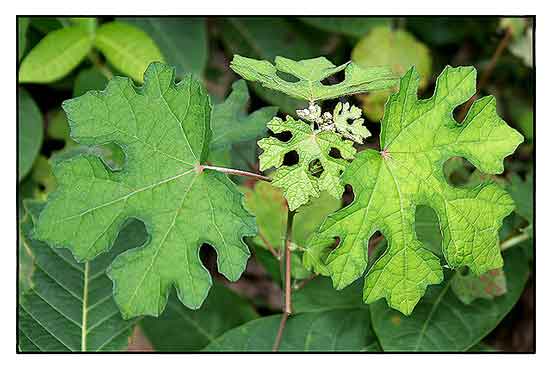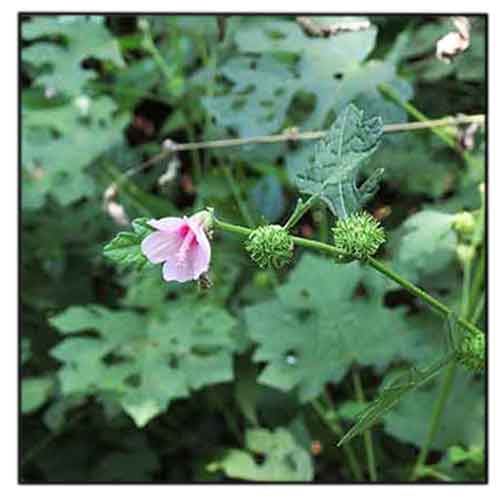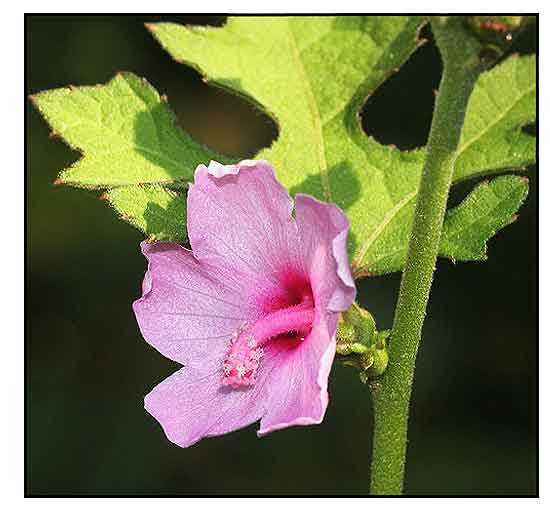 Gen info Gen info
- Malvaceae is a large family of flowering plants with about 243 genera and 4225 species of herbs, shrubs, and trees (Stevens, 2012). The genus Urea is morphologically very close to the genus Pavonia, and some have proposed merging the two genera (Ong, 2001), The genera Urea, Malvaviscus, and Pavonia have been placed in the tribe Malvaviscae based on genetic,, pollen and morphological studies, (2)
Botany
Urea sinuata is an erect, woody perennial herb or small shrub growing up to 2 m tall. Stems are minutely stellate, pubescent or glabrate. Leaves are simple, alternate, and broadly ovate, up to 6 cm long, palmately lobed or deeply pinnatifid; lobes are rounded or obtuse, margin serrate, the upper surface rough and the under-surface grayish. Flowers are small, showy, hibiscus-like, solitary on short stalks in leaf axils, with 5 petals, rose or pink and darker at the base, rounded, up to 1.5 cm long, stamens fused into a pink column beneath a 5-lobed style. Fruits are small, barbed, spiny capsules, 6 to 8 mm in diameter, containing one dark brown seed (Liogier, 1988; Rondon 2009). (2)
Note: Urena sinuata looks very similar to U. lobata, but can be distinguished by leaf characteristics: Urena lobata leaf blades are generally sub-entire or angular lobed, while U. sinuata leaf blades are deeply 3- to 5-palmately parted with sinuses of the segments broad and rounded (Liogier, 1988) (2)
Distribution
- Introduced; naturalized. (9)
- Native
to Andaman Is., Assam, Bangladesh, Cambodia, Cayman Is., Christmas I., Colombia, Costa Rica, Cuba, Dominican Republic, East Himalaya, El Salvador, Haiti, India, Japan, Jawa, Kenya, Laccadive Is., Leeward Is., Madagascar, Malaya, Nansei-shoto, Nicobar Is., Panamá, Puerto Rico, Solomon Is., Sri Lanka, Tanzania, Trinidad-Tobago, Venezuela, Venezuelan Antilles, Vietnam, Windward Is. (1)
- Also found in North and South America.
-
Considered an invasive environmental weed in Puerto Rico, US Virgin Islands, Trinidad, Mexico and Southeast Asia. (2)
 Constituents Constituents
- Phytochemical study of fresh leaves for flavonoids yielded major components viz., quercetagetin-6,7-O--dimethyleyher-3'-ß-D-gluco-pyranoside (I),
quercetagetin-6-7-O-dimethylether-4'-ß-D-glucopyranoside (II), and quercetagetin-6,7-O-dimethylether-3-ß-D-glucopyranoside (III). (see study below) (4)
- Phytochemical screening of air-dried leaves yielded carbohydrates and gum, reducing sugar, alkaloid, steroid, glycoside, and flavonoids. (see study below) (5)
- Phytochemical screening of plant yielded carbohydrates,
Properties
Studies have suggest antioxidant, thrombolytic, insecticidal, repellent, sedative, anxiolytic, anti-diarrheal, anti-inflammatory, analgesic properties.
Parts used
Leaves, roots, stems.
 Uses Uses
Folkloric
- In Venezuela, infusion of foliage is used as anti-inflammatory, analgesic, and used as treatment for kidney pain and gallstone. (4)
- In Tamil Nadu, leaf powder along with leaves of Jasminum flexile Vahl mixed in water is taken internally to cure itching and skin diseases. (11)
- In Trinidad and Tobago,
used for reproductive purposes; for "man's disease" and "man's waist pain." (14)
- In Dominica,
plant with addition of salt taken to cure stomach ache. (15)
Others
- Fiber: Bark yields a strong fiber, easily extractable for the manufacture of sacking and twine. (1) Cultivated for its termite and water resistant fiver; used for making fish line, rope, and binding cords. (10)
Studies
• Insecticidal / Repellent / Leaf, Root, and Stem: Study evaluated the insecticidal and repellent activities of chloroform extracts of fruit, leaf, root and stem of Urea sinuata against the red flour beetle Tribolium castaneum L. adults. The leaf, root and stem extracts showed high toxicity with mortality of the beetles within 30 min of exposure. Insecticidal activity was in the order of fruit > root > leaf > stems stem extracts. The root and stem showed repellent activity at p<0.01 and p<0.05 levels of significance, while the fruit and leaf extracts showed no repellency at all. (3)
• Flavonoids / Cytotoxicity / Leaves: Study of fresh leaves yielded three quercetagetin flavonoids. Compounds I and III showed similar DL50 values 1000 ppm, which point out low cytotoxicity for the three compounds to Artemia salina. (see constituents above) (4)
• Thrombolytic / Leaves: Study evaluated the thrombolytic properties of chloroform extract of air-dried leaves of Urea sinuata. The percent lytic activity was compared with water (positive control) and standard enzyme streptokinase (negative control). The mean percent lytic activity was 47.89%, which is significant thrombolytic activity. (see constituents above) (5)
• Antioxidant / Leaves: Study evaluated the antioxidant potential of chloroform extract of Urea sinuata using DPPH radical scavenging assay. Results showed significant scavenging activity which increased with concentration with IC50 of 10.64 µg/ml , compared to ascorbic IC50 of 1.61 µg/ml. (6)
• Sedative / Anxiolytic / Analgesic / Leaves: Study evaluated the CNS depressant potential of U. sinuata leaves in rodent animal models. Methanol extract displayed a suppressive effect on motor activity, exploratory behavior in hole cross and open field tests and prolongation of thiopental sleeping time in mice. The extract significantly (p<0.5) increase the time spent in elevated plus maze test (EPM). The extract showed centrally acting analgesic potential in formalin induced licking response model and per peripheral analgesic activity using acetic acid-induced writhing test and tail immersion test. (7)
• Antidiarrheal / Leaves: Study evaluated the antidiarrheal activity of crude methanol extract and fractions of Urena sinuata by castor oil-induced diarrhea, castor oil-induced enteropooling and gastrointestinal motility test. The ethyl acetate fraction significantly (p<0.01) reduced diarrheal severity by 37.01%, compared to 44.78% inhibition by standard drug loperamide. The hydromethanol and ethyl acetate fractions and crude ME also significantly (p<0.01) reduced intestinal volume in castor oil-induced enteropooling. (8)
• Anti-Inflammatory / Anxiolytic / Analgesic / Leaves: Study evaluated ethanolic leaf extract of Urena sinuata (ELEUS) for anti-inflammatory activity using egg albumin model, anxiolytic activity using elevated plus maze test, and antioxidant activity using DPPH and hydroxyl radical assays in adult Swiss albino mice. Results suggest the ELEUS exhibited significant (p<0.05) concentration dependent antioxidant and anti-inflammatory effects, with highest activity observed at 100 µg/mL. The extract also exhibited significant (p<0.05) dose dependent anxiolytic effect. ELEUS 200 and 400 mg/kg significantly (p<0.05) , potentiated the anxiolytic activity of standard drug DZP (diazepam) (2 mg/kg). Quercetagetin-6,7-O-dimethylether-3 ′-β-D-gluco-pyranoside, querceta-getin-6,7-O-dimethylether-4 ′-β-D glucopyranoside, and quercetagetin-6,7-O-dimethylether-3-β-D-glucopyranosid of U. sinuata showed better interaction capacity with the GABAA receptor protein (α1, α2, α3, α4, α5, and α6) than diazepam. Results suggest a good source of plant-based therapeutically active lead compounds for inflammation, oxidative stress, neurological disease, and anxiety disorders. (13)
Availability
Wild-crafted.
|

![]()






